Analyzing the Impact of CPOE Systems in the Healthcare Environment
VerifiedAdded on 2022/10/09
|10
|1905
|13
Report
AI Summary
This report provides a comprehensive overview of the impact of Computerized Physician Order Entry (CPOE) systems on the healthcare environment. It highlights the benefits of CPOE, such as improved efficiency, reduced errors, streamlined inventory management, and enhanced patient satisfaction through features like electronic medical records and appointment requests. The report also acknowledges the drawbacks, including potential employee laziness, system errors, and resistance to change among practitioners. The analysis emphasizes the positive overall impact of CPOE in modernizing healthcare operations, advocating for its use to increase business efficiency while acknowledging the need to address associated challenges. The report references various studies and research papers to support its findings, concluding that while CPOE systems offer significant advantages, careful implementation and management are crucial to mitigate potential negative consequences.

Impact of CPOE
Paraphrase This Document
Need a fresh take? Get an instant paraphrase of this document with our AI Paraphraser
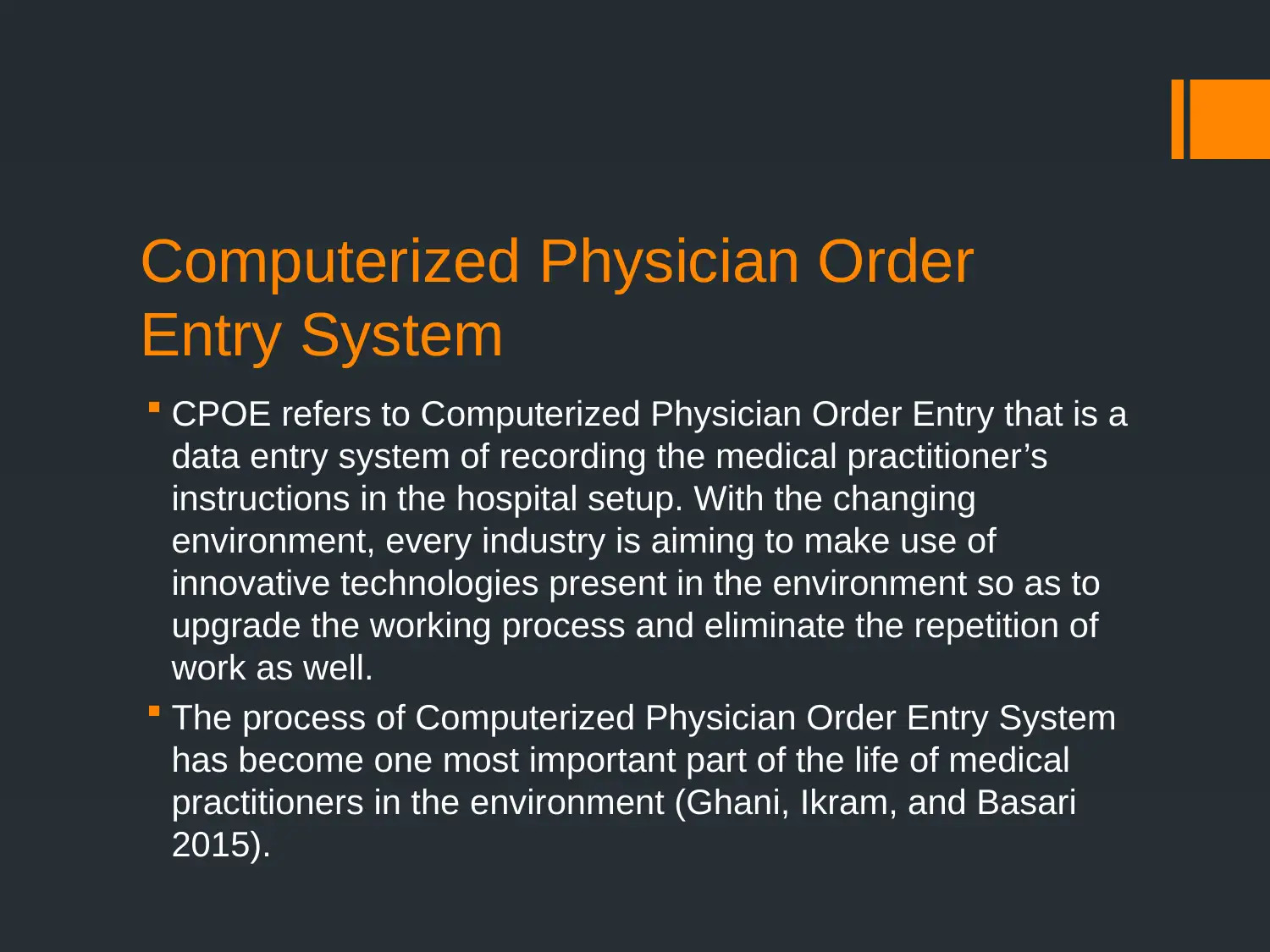
Computerized Physician Order
Entry System
CPOE refers to Computerized Physician Order Entry that is a
data entry system of recording the medical practitioner’s
instructions in the hospital setup. With the changing
environment, every industry is aiming to make use of
innovative technologies present in the environment so as to
upgrade the working process and eliminate the repetition of
work as well.
The process of Computerized Physician Order Entry System
has become one most important part of the life of medical
practitioners in the environment (Ghani, Ikram, and Basari
2015).
Entry System
CPOE refers to Computerized Physician Order Entry that is a
data entry system of recording the medical practitioner’s
instructions in the hospital setup. With the changing
environment, every industry is aiming to make use of
innovative technologies present in the environment so as to
upgrade the working process and eliminate the repetition of
work as well.
The process of Computerized Physician Order Entry System
has become one most important part of the life of medical
practitioners in the environment (Ghani, Ikram, and Basari
2015).
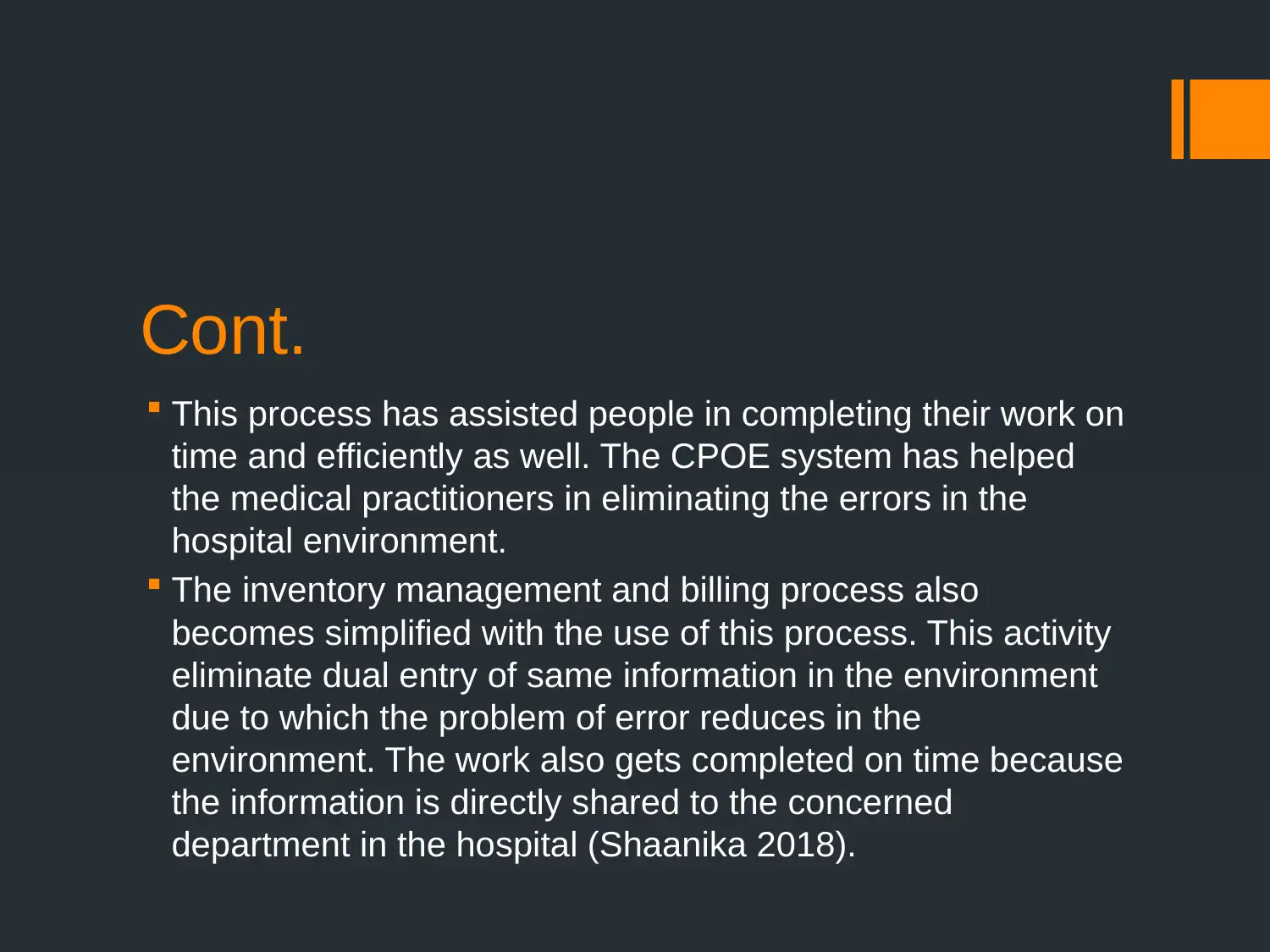
Cont.
This process has assisted people in completing their work on
time and efficiently as well. The CPOE system has helped
the medical practitioners in eliminating the errors in the
hospital environment.
The inventory management and billing process also
becomes simplified with the use of this process. This activity
eliminate dual entry of same information in the environment
due to which the problem of error reduces in the
environment. The work also gets completed on time because
the information is directly shared to the concerned
department in the hospital (Shaanika 2018).
This process has assisted people in completing their work on
time and efficiently as well. The CPOE system has helped
the medical practitioners in eliminating the errors in the
hospital environment.
The inventory management and billing process also
becomes simplified with the use of this process. This activity
eliminate dual entry of same information in the environment
due to which the problem of error reduces in the
environment. The work also gets completed on time because
the information is directly shared to the concerned
department in the hospital (Shaanika 2018).
⊘ This is a preview!⊘
Do you want full access?
Subscribe today to unlock all pages.

Trusted by 1+ million students worldwide
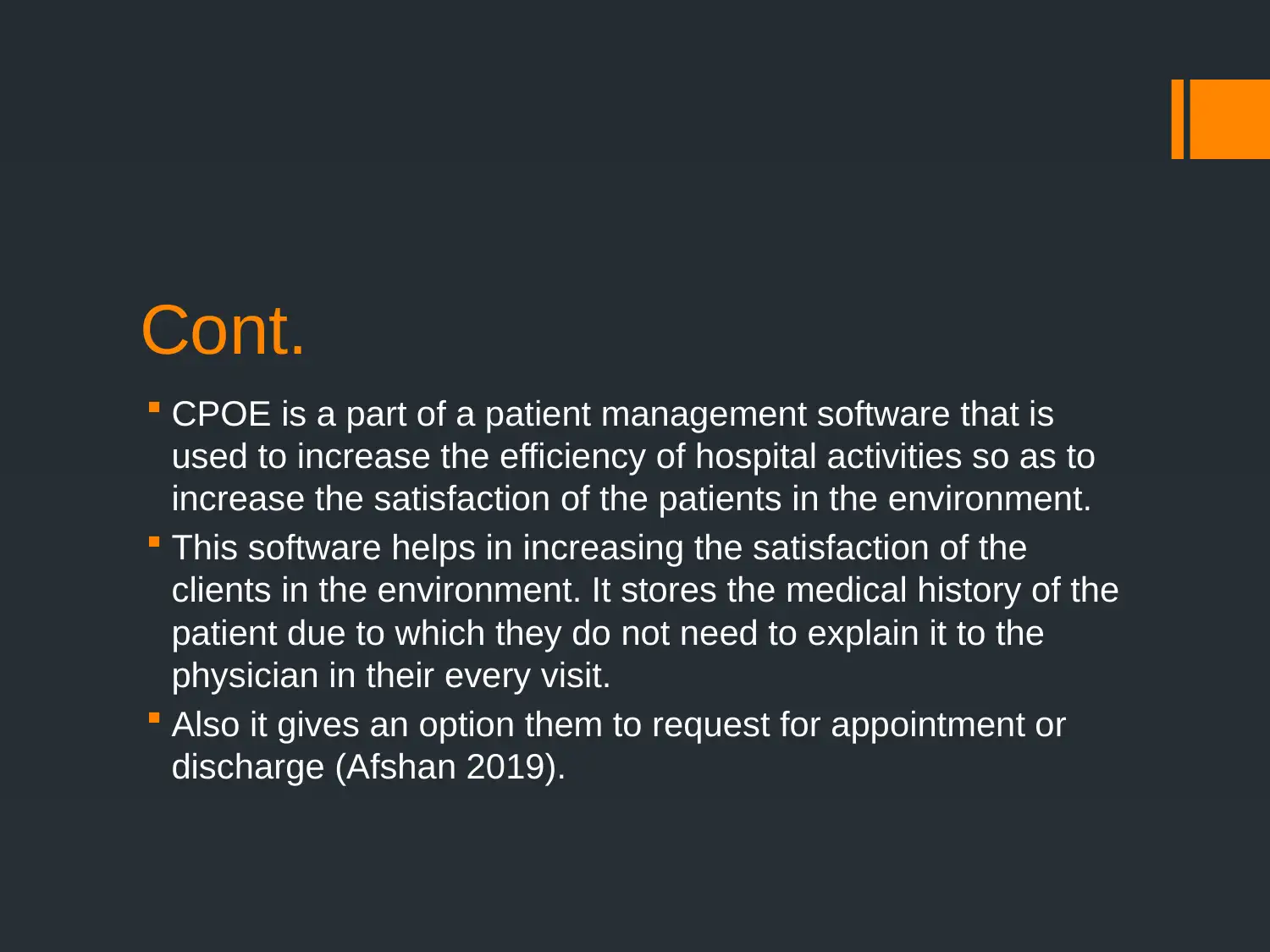
Cont.
CPOE is a part of a patient management software that is
used to increase the efficiency of hospital activities so as to
increase the satisfaction of the patients in the environment.
This software helps in increasing the satisfaction of the
clients in the environment. It stores the medical history of the
patient due to which they do not need to explain it to the
physician in their every visit.
Also it gives an option them to request for appointment or
discharge (Afshan 2019).
CPOE is a part of a patient management software that is
used to increase the efficiency of hospital activities so as to
increase the satisfaction of the patients in the environment.
This software helps in increasing the satisfaction of the
clients in the environment. It stores the medical history of the
patient due to which they do not need to explain it to the
physician in their every visit.
Also it gives an option them to request for appointment or
discharge (Afshan 2019).
Paraphrase This Document
Need a fresh take? Get an instant paraphrase of this document with our AI Paraphraser
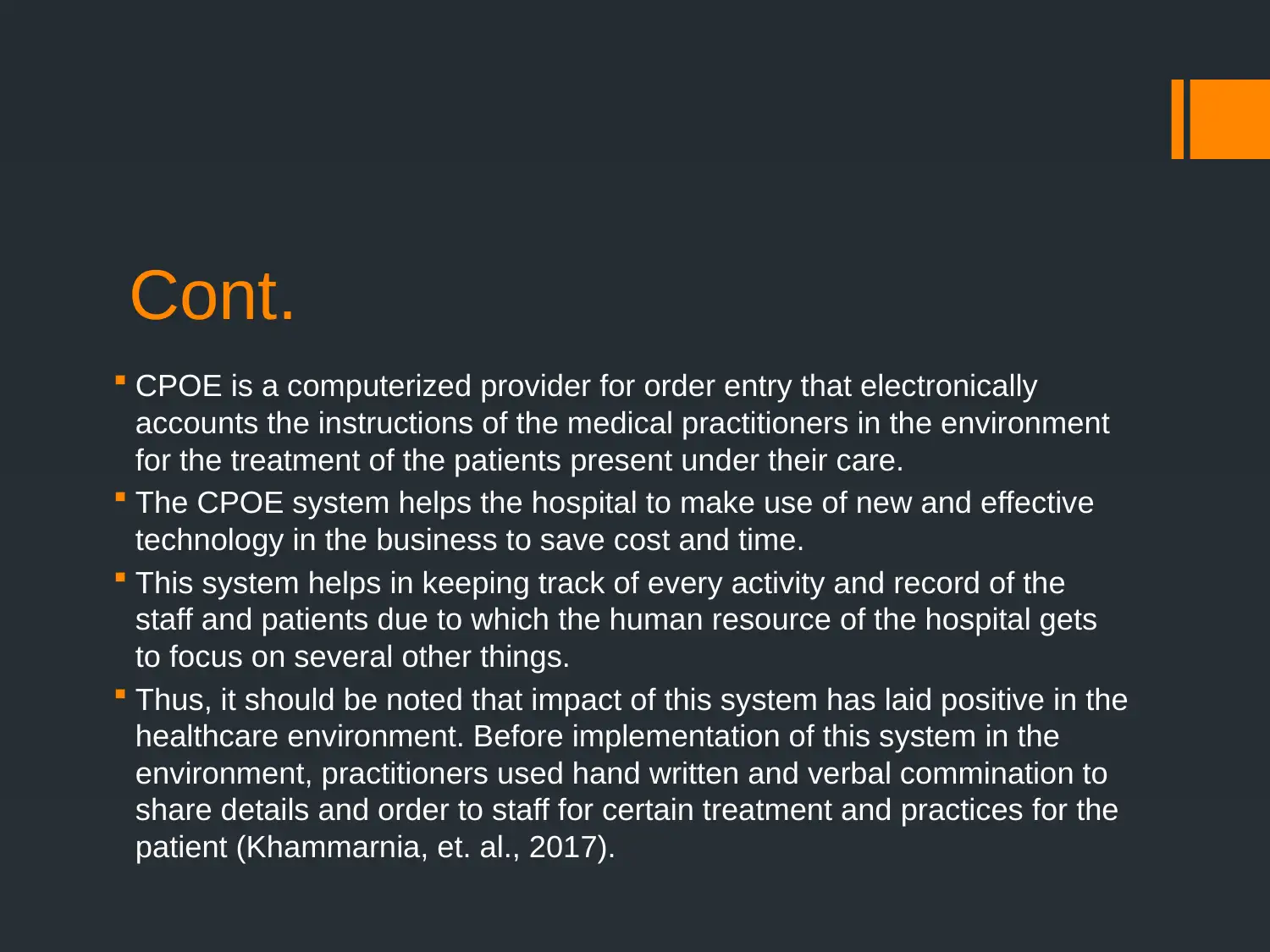
Cont.
CPOE is a computerized provider for order entry that electronically
accounts the instructions of the medical practitioners in the environment
for the treatment of the patients present under their care.
The CPOE system helps the hospital to make use of new and effective
technology in the business to save cost and time.
This system helps in keeping track of every activity and record of the
staff and patients due to which the human resource of the hospital gets
to focus on several other things.
Thus, it should be noted that impact of this system has laid positive in the
healthcare environment. Before implementation of this system in the
environment, practitioners used hand written and verbal commination to
share details and order to staff for certain treatment and practices for the
patient (Khammarnia, et. al., 2017).
CPOE is a computerized provider for order entry that electronically
accounts the instructions of the medical practitioners in the environment
for the treatment of the patients present under their care.
The CPOE system helps the hospital to make use of new and effective
technology in the business to save cost and time.
This system helps in keeping track of every activity and record of the
staff and patients due to which the human resource of the hospital gets
to focus on several other things.
Thus, it should be noted that impact of this system has laid positive in the
healthcare environment. Before implementation of this system in the
environment, practitioners used hand written and verbal commination to
share details and order to staff for certain treatment and practices for the
patient (Khammarnia, et. al., 2017).

Cont.
However, there are several drawbacks of using this system as well. As
this system makes the employees lazy and inefficient. The employees
start to believe that the software can do most of their work so they can
relax.
Also system errors are one of the major reason causing dissatisfaction
among people. It can create chaotic conditions for the hospitals to
handle.
Lastly, resistance to change on the end of practitioners is also an
impact of this process only. During the initial phase of implementation
of this system in the healthcare, many medical practitioners resisted to
implement such changes in the environment because of computerized
system that eliminated the work of manpower (Frisse, et. al., 2016).
However, there are several drawbacks of using this system as well. As
this system makes the employees lazy and inefficient. The employees
start to believe that the software can do most of their work so they can
relax.
Also system errors are one of the major reason causing dissatisfaction
among people. It can create chaotic conditions for the hospitals to
handle.
Lastly, resistance to change on the end of practitioners is also an
impact of this process only. During the initial phase of implementation
of this system in the healthcare, many medical practitioners resisted to
implement such changes in the environment because of computerized
system that eliminated the work of manpower (Frisse, et. al., 2016).
⊘ This is a preview!⊘
Do you want full access?
Subscribe today to unlock all pages.

Trusted by 1+ million students worldwide
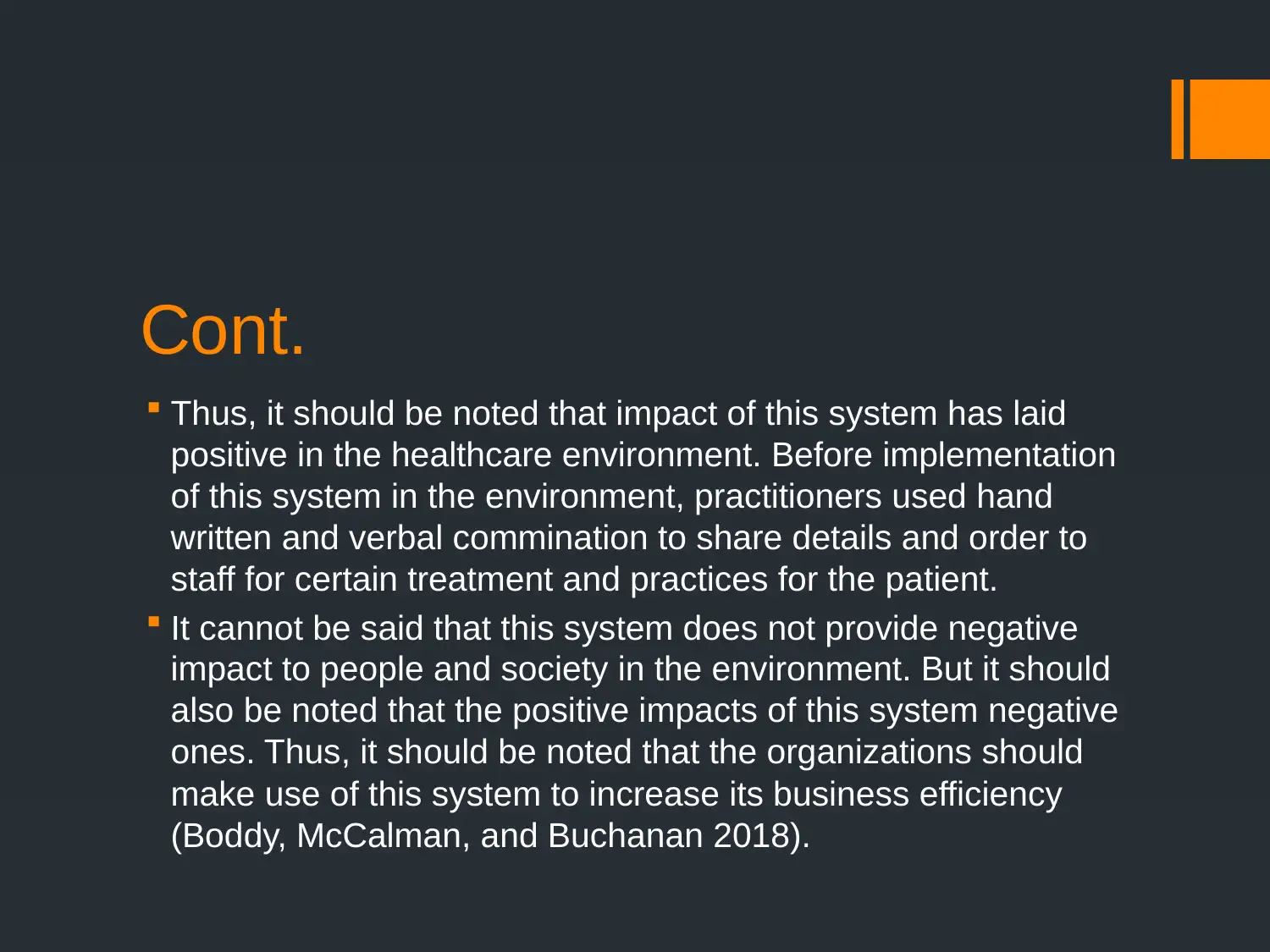
Cont.
Thus, it should be noted that impact of this system has laid
positive in the healthcare environment. Before implementation
of this system in the environment, practitioners used hand
written and verbal commination to share details and order to
staff for certain treatment and practices for the patient.
It cannot be said that this system does not provide negative
impact to people and society in the environment. But it should
also be noted that the positive impacts of this system negative
ones. Thus, it should be noted that the organizations should
make use of this system to increase its business efficiency
(Boddy, McCalman, and Buchanan 2018).
Thus, it should be noted that impact of this system has laid
positive in the healthcare environment. Before implementation
of this system in the environment, practitioners used hand
written and verbal commination to share details and order to
staff for certain treatment and practices for the patient.
It cannot be said that this system does not provide negative
impact to people and society in the environment. But it should
also be noted that the positive impacts of this system negative
ones. Thus, it should be noted that the organizations should
make use of this system to increase its business efficiency
(Boddy, McCalman, and Buchanan 2018).
Paraphrase This Document
Need a fresh take? Get an instant paraphrase of this document with our AI Paraphraser

Conclusion
Thus, in the limelight of above mentioned events, the fact
should be noted that the paper highlighted details about the
impact of CPOE system. The computerized physician
operating entry helps the organization in backing up details
about the patients in a hospital and increasing the flow of
work in the environment. However, this process also bring
several complications in the environment as it bring system
glitches and inefficient activities of employees as well.
Thus, in the limelight of above mentioned events, the fact
should be noted that the paper highlighted details about the
impact of CPOE system. The computerized physician
operating entry helps the organization in backing up details
about the patients in a hospital and increasing the flow of
work in the environment. However, this process also bring
several complications in the environment as it bring system
glitches and inefficient activities of employees as well.
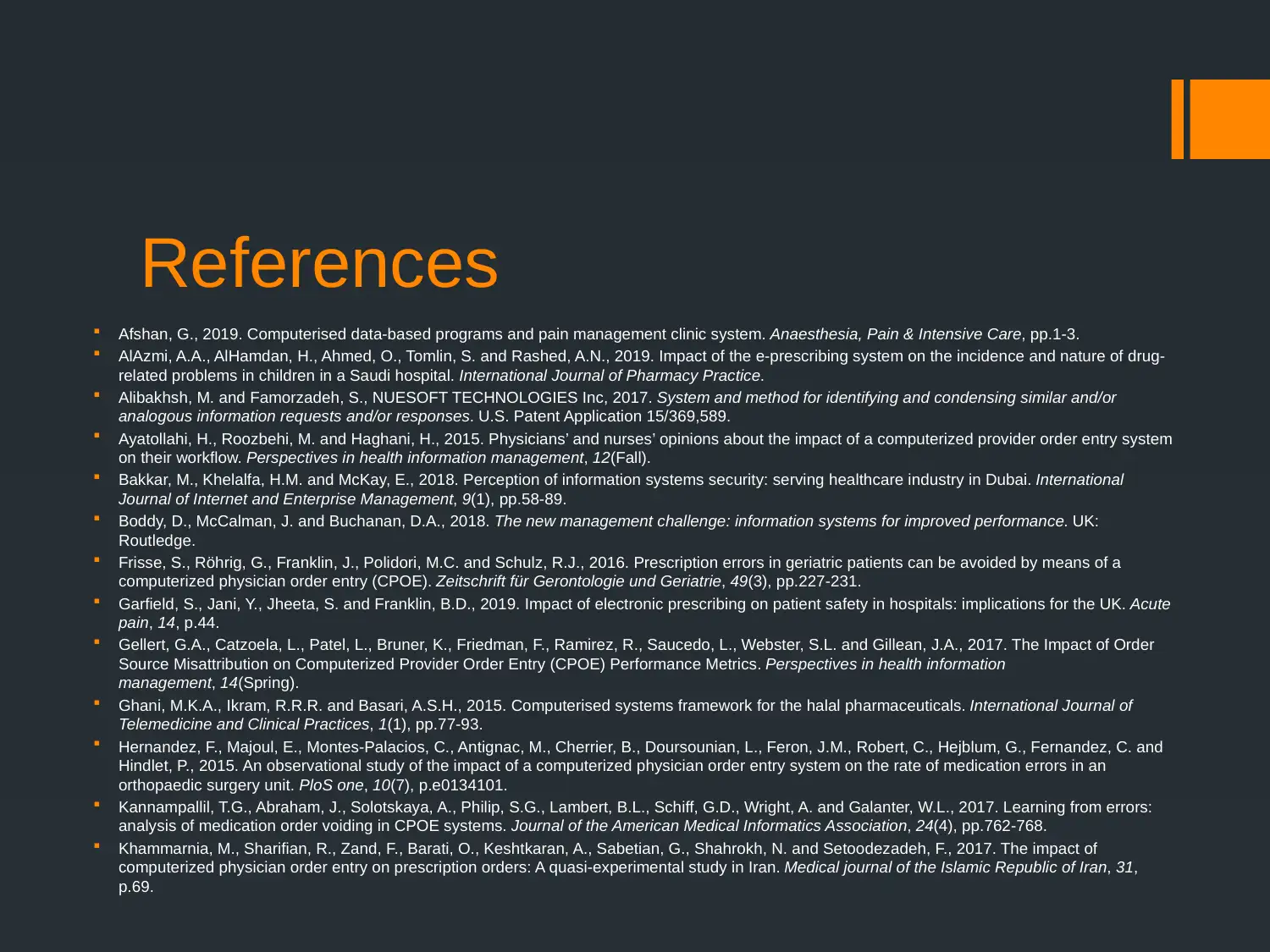
References
Afshan, G., 2019. Computerised data-based programs and pain management clinic system. Anaesthesia, Pain & Intensive Care, pp.1-3.
AlAzmi, A.A., AlHamdan, H., Ahmed, O., Tomlin, S. and Rashed, A.N., 2019. Impact of the e‐prescribing system on the incidence and nature of drug‐
related problems in children in a Saudi hospital. International Journal of Pharmacy Practice.
Alibakhsh, M. and Famorzadeh, S., NUESOFT TECHNOLOGIES Inc, 2017. System and method for identifying and condensing similar and/or
analogous information requests and/or responses. U.S. Patent Application 15/369,589.
Ayatollahi, H., Roozbehi, M. and Haghani, H., 2015. Physicians’ and nurses’ opinions about the impact of a computerized provider order entry system
on their workflow. Perspectives in health information management, 12(Fall).
Bakkar, M., Khelalfa, H.M. and McKay, E., 2018. Perception of information systems security: serving healthcare industry in Dubai. International
Journal of Internet and Enterprise Management, 9(1), pp.58-89.
Boddy, D., McCalman, J. and Buchanan, D.A., 2018. The new management challenge: information systems for improved performance. UK:
Routledge.
Frisse, S., Röhrig, G., Franklin, J., Polidori, M.C. and Schulz, R.J., 2016. Prescription errors in geriatric patients can be avoided by means of a
computerized physician order entry (CPOE). Zeitschrift für Gerontologie und Geriatrie, 49(3), pp.227-231.
Garfield, S., Jani, Y., Jheeta, S. and Franklin, B.D., 2019. Impact of electronic prescribing on patient safety in hospitals: implications for the UK. Acute
pain, 14, p.44.
Gellert, G.A., Catzoela, L., Patel, L., Bruner, K., Friedman, F., Ramirez, R., Saucedo, L., Webster, S.L. and Gillean, J.A., 2017. The Impact of Order
Source Misattribution on Computerized Provider Order Entry (CPOE) Performance Metrics. Perspectives in health information
management, 14(Spring).
Ghani, M.K.A., Ikram, R.R.R. and Basari, A.S.H., 2015. Computerised systems framework for the halal pharmaceuticals. International Journal of
Telemedicine and Clinical Practices, 1(1), pp.77-93.
Hernandez, F., Majoul, E., Montes-Palacios, C., Antignac, M., Cherrier, B., Doursounian, L., Feron, J.M., Robert, C., Hejblum, G., Fernandez, C. and
Hindlet, P., 2015. An observational study of the impact of a computerized physician order entry system on the rate of medication errors in an
orthopaedic surgery unit. PloS one, 10(7), p.e0134101.
Kannampallil, T.G., Abraham, J., Solotskaya, A., Philip, S.G., Lambert, B.L., Schiff, G.D., Wright, A. and Galanter, W.L., 2017. Learning from errors:
analysis of medication order voiding in CPOE systems. Journal of the American Medical Informatics Association, 24(4), pp.762-768.
Khammarnia, M., Sharifian, R., Zand, F., Barati, O., Keshtkaran, A., Sabetian, G., Shahrokh, N. and Setoodezadeh, F., 2017. The impact of
computerized physician order entry on prescription orders: A quasi-experimental study in Iran. Medical journal of the Islamic Republic of Iran, 31,
p.69.
Afshan, G., 2019. Computerised data-based programs and pain management clinic system. Anaesthesia, Pain & Intensive Care, pp.1-3.
AlAzmi, A.A., AlHamdan, H., Ahmed, O., Tomlin, S. and Rashed, A.N., 2019. Impact of the e‐prescribing system on the incidence and nature of drug‐
related problems in children in a Saudi hospital. International Journal of Pharmacy Practice.
Alibakhsh, M. and Famorzadeh, S., NUESOFT TECHNOLOGIES Inc, 2017. System and method for identifying and condensing similar and/or
analogous information requests and/or responses. U.S. Patent Application 15/369,589.
Ayatollahi, H., Roozbehi, M. and Haghani, H., 2015. Physicians’ and nurses’ opinions about the impact of a computerized provider order entry system
on their workflow. Perspectives in health information management, 12(Fall).
Bakkar, M., Khelalfa, H.M. and McKay, E., 2018. Perception of information systems security: serving healthcare industry in Dubai. International
Journal of Internet and Enterprise Management, 9(1), pp.58-89.
Boddy, D., McCalman, J. and Buchanan, D.A., 2018. The new management challenge: information systems for improved performance. UK:
Routledge.
Frisse, S., Röhrig, G., Franklin, J., Polidori, M.C. and Schulz, R.J., 2016. Prescription errors in geriatric patients can be avoided by means of a
computerized physician order entry (CPOE). Zeitschrift für Gerontologie und Geriatrie, 49(3), pp.227-231.
Garfield, S., Jani, Y., Jheeta, S. and Franklin, B.D., 2019. Impact of electronic prescribing on patient safety in hospitals: implications for the UK. Acute
pain, 14, p.44.
Gellert, G.A., Catzoela, L., Patel, L., Bruner, K., Friedman, F., Ramirez, R., Saucedo, L., Webster, S.L. and Gillean, J.A., 2017. The Impact of Order
Source Misattribution on Computerized Provider Order Entry (CPOE) Performance Metrics. Perspectives in health information
management, 14(Spring).
Ghani, M.K.A., Ikram, R.R.R. and Basari, A.S.H., 2015. Computerised systems framework for the halal pharmaceuticals. International Journal of
Telemedicine and Clinical Practices, 1(1), pp.77-93.
Hernandez, F., Majoul, E., Montes-Palacios, C., Antignac, M., Cherrier, B., Doursounian, L., Feron, J.M., Robert, C., Hejblum, G., Fernandez, C. and
Hindlet, P., 2015. An observational study of the impact of a computerized physician order entry system on the rate of medication errors in an
orthopaedic surgery unit. PloS one, 10(7), p.e0134101.
Kannampallil, T.G., Abraham, J., Solotskaya, A., Philip, S.G., Lambert, B.L., Schiff, G.D., Wright, A. and Galanter, W.L., 2017. Learning from errors:
analysis of medication order voiding in CPOE systems. Journal of the American Medical Informatics Association, 24(4), pp.762-768.
Khammarnia, M., Sharifian, R., Zand, F., Barati, O., Keshtkaran, A., Sabetian, G., Shahrokh, N. and Setoodezadeh, F., 2017. The impact of
computerized physician order entry on prescription orders: A quasi-experimental study in Iran. Medical journal of the Islamic Republic of Iran, 31,
p.69.
⊘ This is a preview!⊘
Do you want full access?
Subscribe today to unlock all pages.

Trusted by 1+ million students worldwide
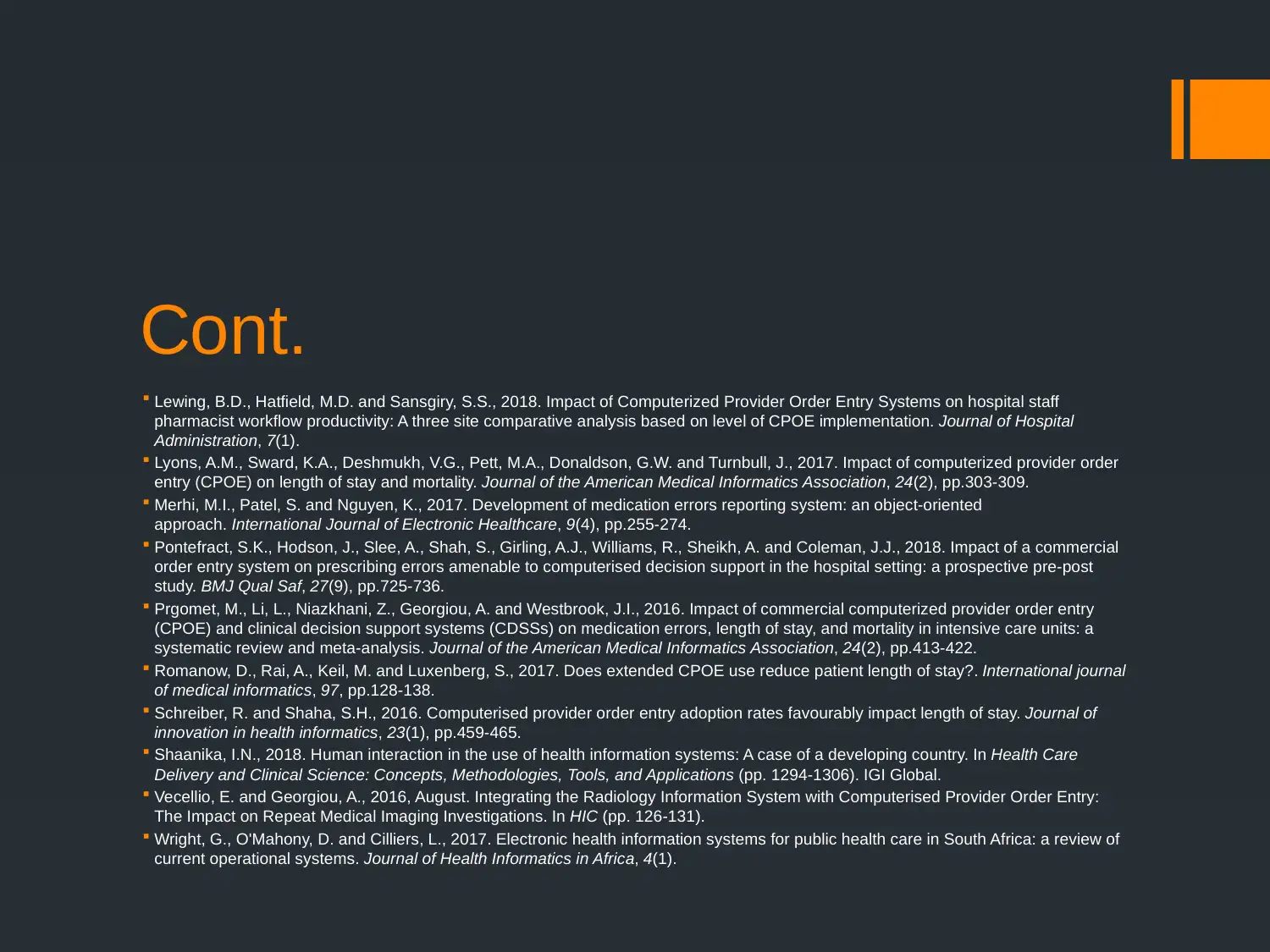
Cont.
Lewing, B.D., Hatfield, M.D. and Sansgiry, S.S., 2018. Impact of Computerized Provider Order Entry Systems on hospital staff
pharmacist workflow productivity: A three site comparative analysis based on level of CPOE implementation. Journal of Hospital
Administration, 7(1).
Lyons, A.M., Sward, K.A., Deshmukh, V.G., Pett, M.A., Donaldson, G.W. and Turnbull, J., 2017. Impact of computerized provider order
entry (CPOE) on length of stay and mortality. Journal of the American Medical Informatics Association, 24(2), pp.303-309.
Merhi, M.I., Patel, S. and Nguyen, K., 2017. Development of medication errors reporting system: an object-oriented
approach. International Journal of Electronic Healthcare, 9(4), pp.255-274.
Pontefract, S.K., Hodson, J., Slee, A., Shah, S., Girling, A.J., Williams, R., Sheikh, A. and Coleman, J.J., 2018. Impact of a commercial
order entry system on prescribing errors amenable to computerised decision support in the hospital setting: a prospective pre-post
study. BMJ Qual Saf, 27(9), pp.725-736.
Prgomet, M., Li, L., Niazkhani, Z., Georgiou, A. and Westbrook, J.I., 2016. Impact of commercial computerized provider order entry
(CPOE) and clinical decision support systems (CDSSs) on medication errors, length of stay, and mortality in intensive care units: a
systematic review and meta-analysis. Journal of the American Medical Informatics Association, 24(2), pp.413-422.
Romanow, D., Rai, A., Keil, M. and Luxenberg, S., 2017. Does extended CPOE use reduce patient length of stay?. International journal
of medical informatics, 97, pp.128-138.
Schreiber, R. and Shaha, S.H., 2016. Computerised provider order entry adoption rates favourably impact length of stay. Journal of
innovation in health informatics, 23(1), pp.459-465.
Shaanika, I.N., 2018. Human interaction in the use of health information systems: A case of a developing country. In Health Care
Delivery and Clinical Science: Concepts, Methodologies, Tools, and Applications (pp. 1294-1306). IGI Global.
Vecellio, E. and Georgiou, A., 2016, August. Integrating the Radiology Information System with Computerised Provider Order Entry:
The Impact on Repeat Medical Imaging Investigations. In HIC (pp. 126-131).
Wright, G., O'Mahony, D. and Cilliers, L., 2017. Electronic health information systems for public health care in South Africa: a review of
current operational systems. Journal of Health Informatics in Africa, 4(1).
Lewing, B.D., Hatfield, M.D. and Sansgiry, S.S., 2018. Impact of Computerized Provider Order Entry Systems on hospital staff
pharmacist workflow productivity: A three site comparative analysis based on level of CPOE implementation. Journal of Hospital
Administration, 7(1).
Lyons, A.M., Sward, K.A., Deshmukh, V.G., Pett, M.A., Donaldson, G.W. and Turnbull, J., 2017. Impact of computerized provider order
entry (CPOE) on length of stay and mortality. Journal of the American Medical Informatics Association, 24(2), pp.303-309.
Merhi, M.I., Patel, S. and Nguyen, K., 2017. Development of medication errors reporting system: an object-oriented
approach. International Journal of Electronic Healthcare, 9(4), pp.255-274.
Pontefract, S.K., Hodson, J., Slee, A., Shah, S., Girling, A.J., Williams, R., Sheikh, A. and Coleman, J.J., 2018. Impact of a commercial
order entry system on prescribing errors amenable to computerised decision support in the hospital setting: a prospective pre-post
study. BMJ Qual Saf, 27(9), pp.725-736.
Prgomet, M., Li, L., Niazkhani, Z., Georgiou, A. and Westbrook, J.I., 2016. Impact of commercial computerized provider order entry
(CPOE) and clinical decision support systems (CDSSs) on medication errors, length of stay, and mortality in intensive care units: a
systematic review and meta-analysis. Journal of the American Medical Informatics Association, 24(2), pp.413-422.
Romanow, D., Rai, A., Keil, M. and Luxenberg, S., 2017. Does extended CPOE use reduce patient length of stay?. International journal
of medical informatics, 97, pp.128-138.
Schreiber, R. and Shaha, S.H., 2016. Computerised provider order entry adoption rates favourably impact length of stay. Journal of
innovation in health informatics, 23(1), pp.459-465.
Shaanika, I.N., 2018. Human interaction in the use of health information systems: A case of a developing country. In Health Care
Delivery and Clinical Science: Concepts, Methodologies, Tools, and Applications (pp. 1294-1306). IGI Global.
Vecellio, E. and Georgiou, A., 2016, August. Integrating the Radiology Information System with Computerised Provider Order Entry:
The Impact on Repeat Medical Imaging Investigations. In HIC (pp. 126-131).
Wright, G., O'Mahony, D. and Cilliers, L., 2017. Electronic health information systems for public health care in South Africa: a review of
current operational systems. Journal of Health Informatics in Africa, 4(1).
1 out of 10
Related Documents
Your All-in-One AI-Powered Toolkit for Academic Success.
+13062052269
info@desklib.com
Available 24*7 on WhatsApp / Email
![[object Object]](/_next/static/media/star-bottom.7253800d.svg)
Unlock your academic potential
Copyright © 2020–2025 A2Z Services. All Rights Reserved. Developed and managed by ZUCOL.





